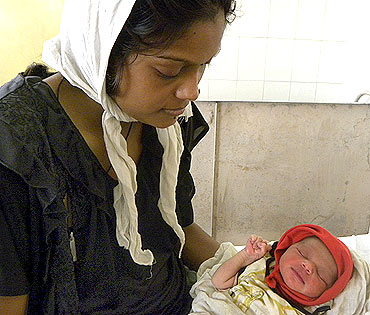
The nooks and corners of Gorakhpur's district hospitals are full of surprises. Take, for instance, the labour room. The privacy of the room where deliveries are carried out is protected by a flimsy and slightly dirty curtain and a door that is always ajar.
If you are a woman, you can saunter in whenever you want to and no one will stop you. A red sign in Hindi -- warning that 'men are not allowed' -- adorns the entrance.
On a particularly busy day, the hospital records as many as 22-25 deliveries. October 31, when the day world's seven billionth baby was born, happened to be one of those days.
One of the nurses told us, "This is a busy day for us. Most of the women brought here went into labour because they were fasting for Chhath and Jeeyutiya (fasts women keep for the well-being of their sons)."
Of the 25 deliveries that have taken place in the hospital on that day, five are cesarean sections. One of the doctors, who is taking a breather after a night shift, shrugs when asked about the number of babies that survive.
"Ninety per cent of them do," she says.

All the mothers delivering on the day are between the ages of 20 and 35. While the youngest ones are having their first child, the women over 30 are here to deliver their fourth or even fifth child.
Roughly, 10,715 births take place in Gorakhpur and 3,324 of its surrounding villages in a month. The sleepy eastern Uttar Pradesh district sits pretty high in the list of Indian states with high birth rates.
Gorakhpur also has the highest maternal mortality rate in the country.
According to the latest bulletin from the Safe Motherhood Committee of Federation of Obstetric and Gynaecological Societies of India, UP's MMR recorded for the period 2007-2009 was 359, placed only behind Assam (390) and Rajasthan (318).
Dr Sadhna Gupta, chairperson of the committee, gives us the latest figures, "It was 303 last year, 252 in May and 212 as of now. We still may have a long way to go but the situation has certainly improved."
Dr. Gupta, like many other doctors based in Gorakhpur, gives the credit to the National Rural Health Mission. The Janani Suraksha Yojana implemented under NHRM by the government has shown promising results over the years. Introduced in 1995, the scheme encourages and facilitates institutionalised deliveries in Gorakhpur and its surrounding villages.

One of the major reasons behind Gorakhpur's high MMR are primitive methods of deliveries. In this day and age, when medical science has reached incredible heights, the poor in most of eastern UP still go to inexperienced elderly women of the village to deliver their babies.
Under JSY, the government gives Rs 1,400 to the urban poor and Rs 1,000 to expectant mothers from poor rural families if they go to a hospital for delivery through the proper procedure. The expectant mothers are also provided with necessary medication and a vehicle to reach the hospital when they go in labour.
Primary and Community health centres have been set up at block level and sub health centres have been set up in villages. When a delivery gets too complicated for a SHC or a caesarean section is required -- such centres only have one nurse and a single worker -- it is immediately referred to its PHC and a vehicle is provided to ferry the expectant mother.

Local women are appointed to mobilise pregnant woman and encourage them to go to a hospital. They get a commission of Rs 200 for every case they bring in. Such deliveries are called institutional deliveries.
In its first year, JSY saw only 5-6 deliveries but the number has grown. Out of 50,884 deliveries that took place in Gorakhpur and its surrounding villages between April and October this year, 34,392 were institutional.
Dr R N Mishra, chief medical officer at the district hospital, says, "While 30,000 institutional deliveries took place in 2008, last year it was 52,000. This year, the figure is expected to cross 60,000. Mother-child health care is an important issue."
Although the figures show massive improvement, there is still a long way to go. As Dr Mishra puts it, "We still have to reach 100 per cent."